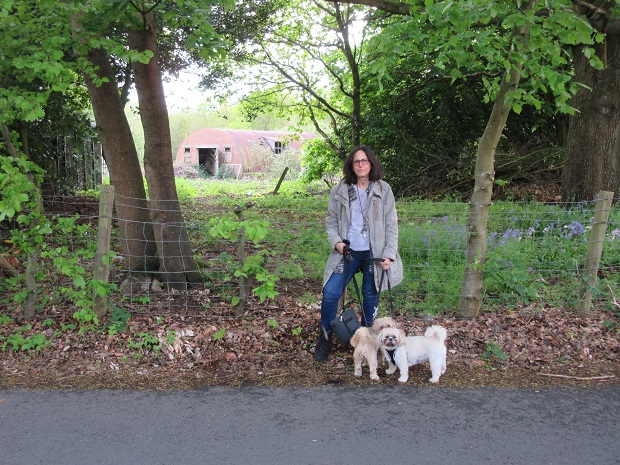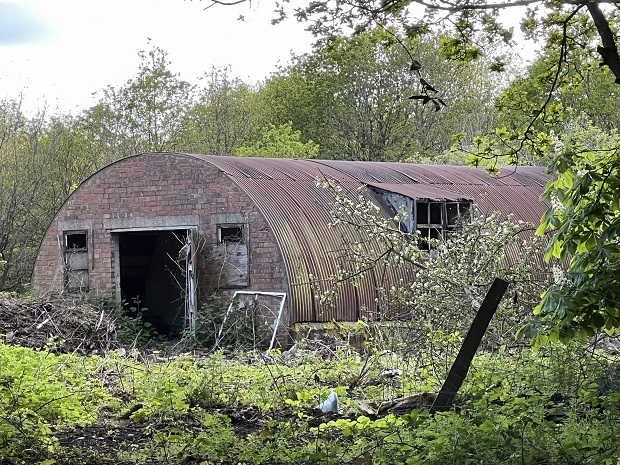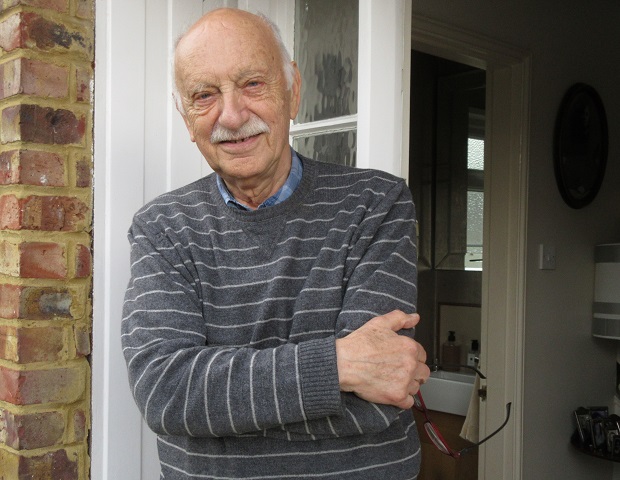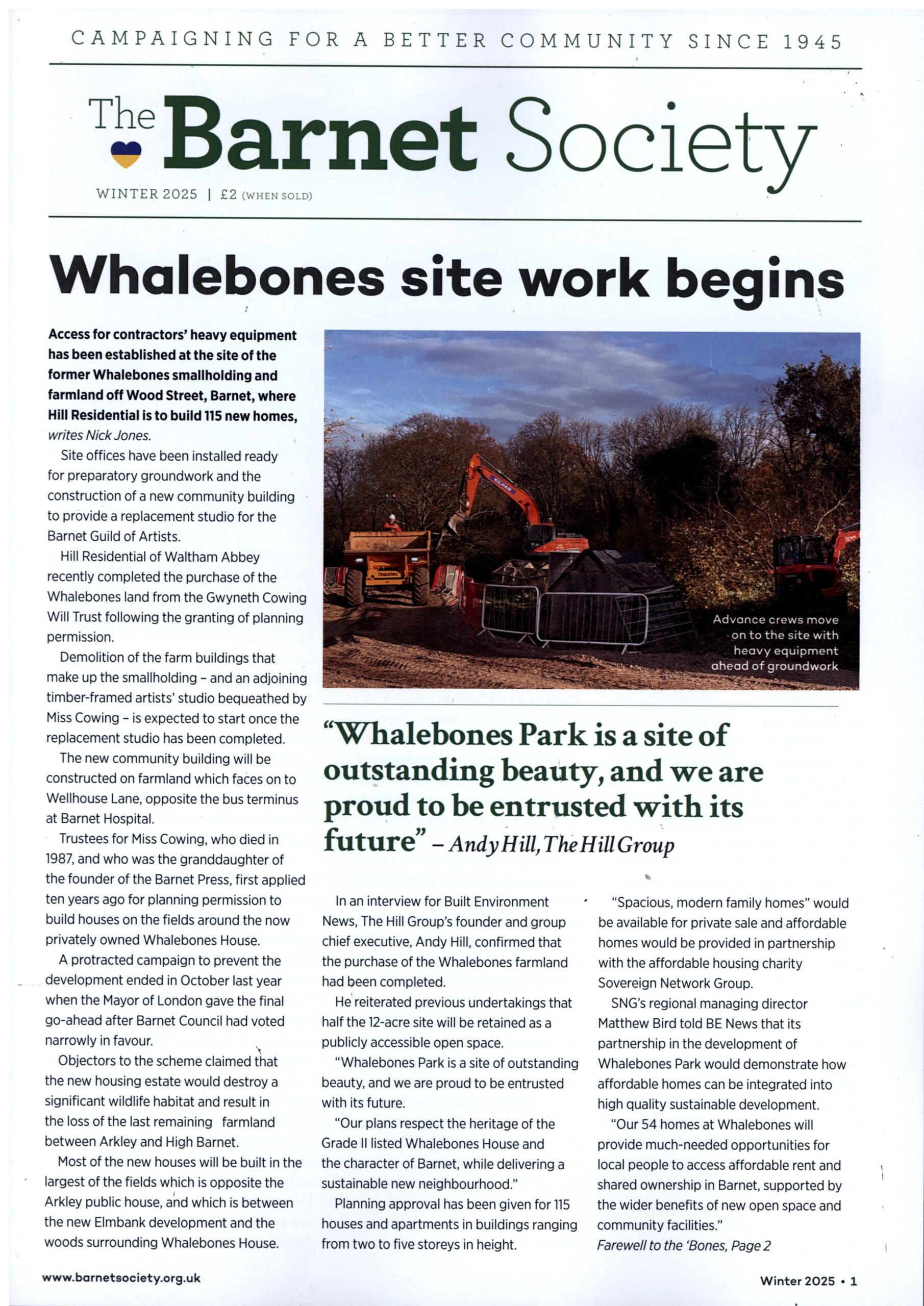Plea to preserve reminder of Arkley’s historic role as listening post for Bletchley Park wartime codebreakers

All that appears to remain of a secret wartime listening post at Arkley is a dilapidated Nissen hut in Rowley Lane which nearby residents fear might be demolished to make way for new housing.
Arkley View was known during World War II as “Post Box 25, Barnet” and it served as one of the outstations for Bletchley Park, the top-secret base for Allied code breaking.
Given Arkley’s role in intercepting and recording German Morse code messages – which were then sent by despatch riders to the codebreakers at Bletchley Park – there is a growing campaign within the locality to see if the Nissen hut can be preserved because of its historical significance.
Arkley resident Hayley Lehmann (see above) thinks it would be a tragedy if this link with the past disappeared without anyone seeing if it could be saved.
“This Nissen hut is part of Arkley’s historic heritage. It is just as important as Arkley’s windmill.
“We do want to raise awareness to what is happening, not least because it seems that a large swathe of Green Belt land might now be under threat of development.”
After the war Sir Winston Churchill ordered that radio masts, equipment and buildings used by the Radio Security Service at Arkley should be taken down and all that appears to remain is the one Nissen hut and evidence of underground air raid shelters.
After being hidden for years behind undergrowth and trees, much of the site ten-acre site has been cleared and the land is now up for sale.

According to the website of estate agents Barnard Marcus Auctions the Nissen hut – described as a “barn”, with 0.8 acres of land – has been sold for £300,000.
The adjoining 9.5-acre plot, which had a guide price of £750,000 remained unsold, but a 1-acre plot is up for auction on 23 May with a guide price of £225,000.
Some nearby residents think that perhaps the only possibility of saving the Nissen hut is to see if Bletchley Park Trust is interested in taking steps to preserve or commemorate the outstations that supplied the codebreakers with intercepts from enemy radio networks.
It is only in recent years that there has been a wider understanding of Arkley’s contribution. Some of the personnel based there, when released from the restrictions of the Official Secrets Act, have described their work.
Arkley View, a large country house which was demolished, was situated on the highest point on Arkley ridge and considered an ideal site for becoming a receiving station for code breaking.
It was one of six large houses requisitioned for use by the Radio Security Service. Huts and masts were erected in the grounds.
Several houses such as Rowley Lodge, The Lawns, and Meadow Bank, were used as billets and training schools. For a time was an intercept training station in High Barnet at Ravenscroft Park.

Arkley resident Peter Kay (87), who previously lived in Totteridge, remembers cycling to Arkley during World War II.
“I was a ten-year-old at the time and we used to cycle past the listening post and we could see the radio masts and Nissen huts.
“If the Bletchley Park trustees are interested in preserving and promoting their outstations, then Arkley is just the place because it clearly had a significant role.”
Amateur radio hams were recruited by the Radio Security Service. Arkley was its headquarters, and it was one of six major out stations that sent intercepts to Bletchley Park to be de-ciphered.
One of those who served at Arkley, the late Cyril Thomas Fairchild, recalled working in one of the Nissen huts intercepting Morse code messages.
Another amateur radio enthusiast recruited by the Radio Security Service was Bob King who said that after being tested on Morse speed and procedure, he was sent to Arkley View and had to identify the radio stations being intercepted.
In a post on the website, Barnet – A Trip Down Memory Lane, Jan French says that she remembers as a child seeing sentry boxes at the entrance to Arkley View.
“Not many people knew what went on there, or that it existed, albeit my mum knew all about it. She worked there as a cypher and code specialist and was transferred to Bletchley Park in 1944.”
The Barnet 4U history page said that Winston Churchill was anxious that Arkley, “where the most secret work was carried out, was raised to the ground and all records, drawing, diagrams etc. destroyed as a precautionary measure.”
16 thoughts on “Plea to preserve reminder of Arkley’s historic role as listening post for Bletchley Park wartime codebreakers”
Comments are closed.


My Mum,Mary French née Hall, worked for the Cypher School. She worked at both Arkley View, Bletchley Park and later in their London Office in the 40’s and 50’s.
I remember the House in Arkley with its sentry box outside.
Such a shame if its given over to housing.
As an Arkley resident, I strongly oppose the building on GREEN BELT land. I am referring to Rowley Lane which is full of wildlife, rabbits, hedgehogs, foxes and other smaller creatures. When will you realise that there are other brownfield sites, and it now seems anything goes?
Also, this piece of land is used daily by dozens of people coming and going, enjoying the countryside and walking their dogs for years on end.
When will you stop this relentless pursuit of building everywhere the WILDLIFE hasn’t got a voice? Also, this land has a strong connection to Bletchley Park, so please protect it.
This piece of history should most definitely be preserved. It is part of our heritage. It would be a travesty if this site was built on. You can bet your life any houses built here wouldn’t be affordable, just giant monstrosities for rich types!
100% agree charles, this is ludicrous nimbyism. We have a housing crisis in London and the argument here is that we shouldn’t build much needed new housing because there is a random, rusty hut from the 1940’s there. Come on
I think this is an inportant part of our heritage and should definitely be preserved. I hope Bletchley Park steps in to save it.
It would be sad to see a piece of history lost.
What a fascinating story! I really hope the hut can be preserved and that more people can learn about its importance.
I was horrified after returning recently from holiday to se that my dog walking early morning walk was confronted the clearing of land close to the historic Nissen hut.
My wife and I have been walking this wood for nearly 40 years on a very regular basis and are very concerned at the rape of an important green belt area. The wood and surrounds are home to a rich variety of wildlife including foxes, rabbits and badgers.
Any planning permission must be vigorously opposed.
I expect that our local MP who lives close by is aware of this problem.
PS I am a member of the Barnet Society and the Arkley Association.
Classic NIMBYs. It’s just an old tin hut from the 1940s. Stop preventing people having the the chance to own a home. Nowhere does it state this is even on the green belt; more likely a brownfield site that should’ve already been used for housing.
Worth preserving the heritage and the green belt as is gradually reducing.
Please do not sell this land to be built
It would be wrong for more green belt development. That’s what people love Arkley for. This listening post should be preserved and the wildlife protected!!
I had no idea about this chapter in Barnet’s history. Surely there is an argument for preserving what’s left for the benefit of local schools to visit. Nothing sparks the imagination more than seeing these things first-hand.
An important part of our history should not be allowed to disappear!
I support this!
Let’s preserve this valuable history
Please PLEASE ?? stop the destruction of the green belt and destruction of significant historical sites. There are enough flashy new builds all around. There is so much nature and dens for rabbits and foxes which has already been cleared, I walk the trail every day and it’s heartbreaking to see it.